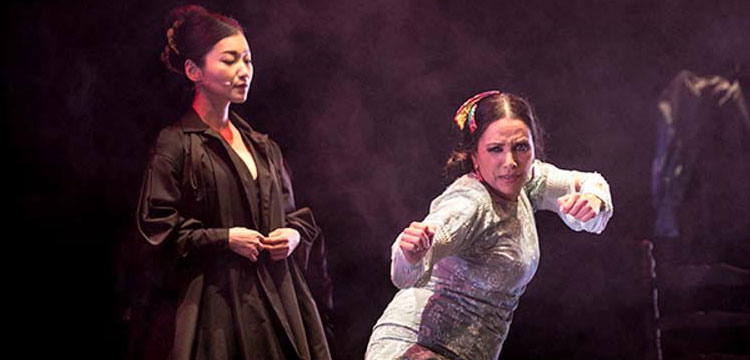Director, idea y choreography: Eva Yerbabuena. Music director and guitar: Paco Jarana. Special collaboration: Anna Sato. Flamenco singing: Miguel Ortega, Alfredo Tejada. Percussion: Antonio Coronel. Taiko: Kaoru Watanabe. Box and congas: Rafael Heredia. Dance: Fernando Jiménez. (video)
Estela Zatania
Leer en español
Special Festival de Jerez
On Sunday evening, with mild weather and Eva Yerbabuena at the Teatro Villamarta, the streets of Jerez were full of people. This dancer’s presence triggers crowds and expectation wherever she goes.
“Cuentos de Azúcar” the show is called, described as an encounter between two cultures and based on the popular music of the island of Amami (Japan). We’ve learned that you can’t be looking for a high flamenco content in Eva’s shows, so you settle into your seat and open your senses to enter as an honored guest into the inner life of Yerbabuena.
Enigmatic Eva. The enigmatic Asian culture. Basically, they seem to be concepts that blend well. Clever tricks with arms and hands, the hypnotic repetition of movements, contemporary dance as a universal expression that knows no frontiers. And the darkness, always the darkness, in the most literal sense. The power of sensory privation forces you to delve into yourself. There are endless ways to deal with the curveballs life throws us. Eva’s is through darkness and silence, supported on this occasion by the sweet voice of Anna Sato. It’s a wintry landscape, without color or energy, as sullen and stern as a martinete sung in Triana.
When you hear the first sounds of caña with soleá apolá, the relief comes faster than from having taken an ibuprofeno tablet. Eva has a love affair with her bata de cola, and we are watching every move. But just when life begins to seem bearable, darkness again envelopes everything, and you don’t know if Asian culture has an affinity with flamenco as the show hopes to show, or if it’s the antithesis.
Among other pieces, Eva dances a rhythmic version of mining song, and the two singers, Miguel Ortega and Alfredo Tejada, both holders of the prestigious Lámpara Minera, deliver all their power that contrasts with the serene voice of the Japanese singer.
Tangos reminds us that Eva grew up in Granada, and with cantiñas and bulería de Cádiz she shows she is the maestra. And everything ends with the two women, Eva and Anna, seated on the floor together sipping tea, representing the cultural brotherhood that didn’t quite come together through the music.
